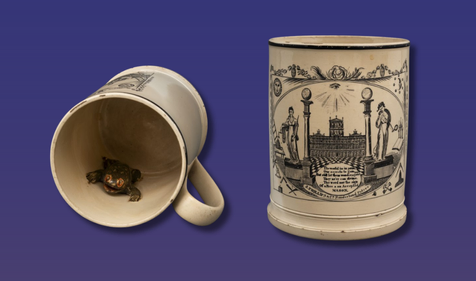Was Robert Burns a Freemason? Journey through Brother Burns’ life and discover how Brotherhood shaped his poetry and his place in history.
In the hearts of Scots and Freemasons alike, few names are held in higher esteem than Robert Burns. He was Scotland’s national bard, the voice of the common man, and a literary giant who crafted verses that stirred the hearts of generations. Known around the world for poems like Auld Lang Syne, To a Mouse, and Tam o’ Shanter, Brother Burns used his pen to champion themes of liberty, equality, Brotherhood, and human dignity.
Initiated into Lodge St. David, Tarbolton, in 1781 at age 23, Robert Burns remained an active and devoted Freemason for the rest of his life. His time in the Craft had a profound impact on his work, worldview, and friendships. Through his poems and personal writings, we find a man whose ideals were shaped by the fraternal bonds of Freemasonry. For members of the Craft, Brother Burns stands as a proud example of how Masonic values of equality, virtue, and Brotherhood can echo through art and endure across centuries.

Early Life and First Steps into Poetry
Born into a hardworking farming family, Robert Burns' early life was one of physical labor, financial hardship, and a fierce emphasis on education. His father, William Burnes[RS1] [RS2] , ensured that Robert and his siblings were taught literature, history, and philosophy despite their modest means. These seeds blossomed into a profound love of language and the vivid imagery of the Scottish countryside that later became the hallmark of Brother Burns' poetry.
By age 15, Brother Burns was already writing verses inspired by everyday life, love, and rural hardship. His first major success came in 1786 with the publication of Poems, Chiefly in the Scottish Dialect, a collection that captured the voice of Scotland’s common people with striking authenticity.
Was Robert Burns a Freemason?
Yes! Not only was Robert Burns a Freemason, but the Craft shaped his worldview and deeply influenced his career. Brother Burns was initiated into Lodge St. David, Tarbolton, on July 4, 1781, at the age of 23. Later that year, he was passed and raised at a joint meeting of St. David’s and St. James’ Lodges. By 1784, he was elected Deputy Master of Lodge St. James, Tarbolton, which was a clear sign of the respect he commanded among his Brethren.
Freemasonry offered Brother Burns more than just fraternity. It gave him a framework of ideals that resonated with his own convictions and echoed through his work. It was within the lodge that Brother Burns found camaraderie, support, and the spirit of humanitarianism that animated both his poems and his personal life.
When Brother Burns faced hardship and the prospect of fleeing to Jamaica to escape financial ruin, it was again his Masonic Brothers who came to his aid, helping publish and promote his poems in acts of generosity that would ultimately save his literary career.
Robert Burns' Masonic Journey
Brother Burns’ Masonic journey took him beyond Tarbolton. In 1786, he was made an honorary member of Lodge Kilmarnock Kilwinning St. John. The following year, during his celebrated stay in Edinburgh, he was admitted into Canongate Kilwinning No. 2, one of Scotland’s most prestigious lodges, and, by tradition, crowned Poet Laureate of the lodge.
His influence and admiration within Freemasonry only grew. Brother Burns was exalted to the Holy Royal Arch in 1787 at Eyemouth’s St. Ebbe’s Lodge. Later, when he moved to Dumfries, he affiliated with Lodge St. Andrew and was elected Senior Warden in 1792.
Robert Burns' Masonic Poems
The topic of Brother Burns’ Masonic poems leads us to some of his most heartfelt and meaningful work. Burns wove Masonic ideals throughout his poetry, while some of his works speak directly to his Brethren.
Farewell to the Brethren of St. James Lodge, Tarbolton
When Brother Burns believed he would leave Scotland for Jamaica, he penned a touching farewell to his brethren:
"Adieu! a heart-warm fond adieu,
Dear brothers of the mystic tie!
Ye favoured, enlighten'd few,
Companions of my social joy..."
Here, Brother Burns speaks to the profound connection, or the “mystic tie,” he felt with his lodge Brothers. The poem also contains references to the "hieroglyphic bright," which is a nod to the secrets and symbols of Freemasonry that only Craftsmen understand.
The Mason’s Apron
Attributed to Brother Burns, “The Mason’s Apron” celebrates the badge of a Mason:
"There's mony a badge that's unco braw,
Wi' ribbon, lace and tape on;
Let Kings and Princes wear them a',
Gie me the Master's apron!"
Brother Burns elevates the Mason’s apron, which we know is simple, honest, and meaningful, above the fine robes of kings and princes. In true Masonic spirit, the badge of a working man carries more honor than the trappings of earthly power.
To Mr. Mackenzie, Surgeon, Mauchline
Burns also wrote lighter, more personal Masonic verses, such as his playful invitation to Dr. Mackenzie of Mauchline for the Lodge’s annual St. John’s Day procession:
"The Master and the Brotherhood
Would a' be glad to see you;
For me I would be mair than proud
To share the mercies wi' you."
Written in 5790 Anno Mundi (Masonic dating), the note blends Brother Burns' wit and warmth with his deep affection for his Brothers. He expertly shows that the friendship and celebration that occur within the Craft go hand-in-hand with moral reflection.
Ye Sons of Old Killie
This song was composed by Brother Burns for a festive meeting of the Kilmarnock Masonic Lodge in 1786, presided over by William Parker, the Master.
"Within this dear mansion, may wayward Contention
Or wither'd Envy ne'er enter;
May secrecy round be the mystical bound,
And brotherly Love be the centre!"
In this poem, Brother Burns toasts the Lodge, offering a prayer that Brotherly love, secrecy, and harmony should always guide its members. It captures the lighthearted camaraderie and the solemn commitment to Masonic virtues that defined Brother Burns’ view of the Craft.
Burns’ Final Years
In his final years, Brother Burns lived in Dumfries with his wife Jean Armour and their young children. He worked as an Excise Supervisor, often traveling long distances on horseback and juggling official duties with songwriting and collecting Scottish folk tunes.
Years of physical labor, stress, and illness took a toll on his health. Likely suffering from a rheumatic heart condition, Brother Burns aged prematurely and struggled with bouts of depression. He died on July 21, 1796, at the young age of 37. His funeral took place four days later, which was the same day his son Maxwell was born. Originally buried under a simple stone, his remains were moved to the Burns Mausoleum in Dumfries in 1817, where Jean Armour was later buried beside him.

The Legacy of Robert Burns in Freemasonry
Robert Burns’ Masonic spirit lives on through his poetry and the fraternity’s enduring admiration for him. Burns Night celebrations still feature his verses and toasts in his honor, reflecting the values he championed: liberty, equality, and Brotherhood.
In 1884, when Rob Morris was named Poet Laureate of Freemasonry in New York, he was recognized as the successor to Brother Burns, which was a testament to Brother Burns’ unmatched legacy within the Craft.
Robert Burns was many things: poet, patriot, and cultural icon. But to Freemasons, he is above all a Brother, and one whose life and work reflect the timeless ideals of the Craft.
Related Stories
Discover additional Scottish Rite blogs and news on this topic.
-
A Jolly Masonic Mug
History
Read More about A Jolly Masonic Mug
-
The Life and Career of Brother Arnold Palmer
Famous Masons
Read More about The Life and Career of Brother Arnold Palmer
-
Manly P. Hall: Philosopher, Mystic, and Freemason
Famous Masons
Read More about Manly P. Hall: Philosopher, Mystic, and Freemason


